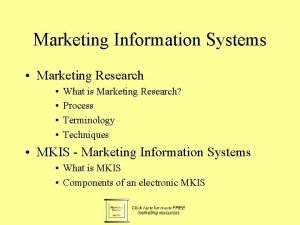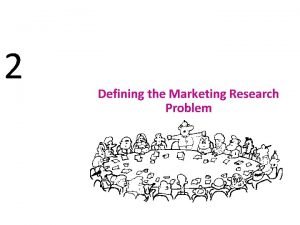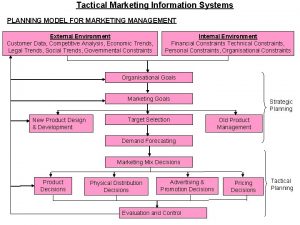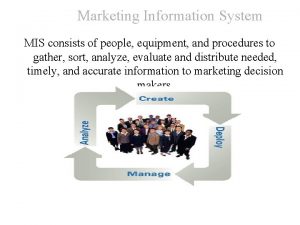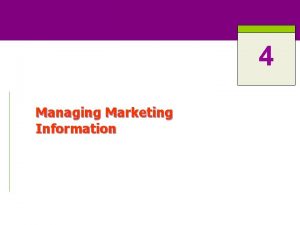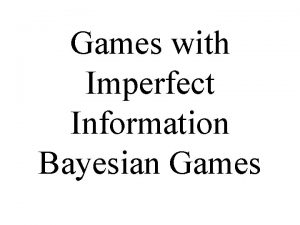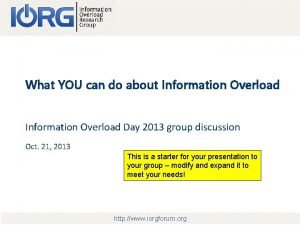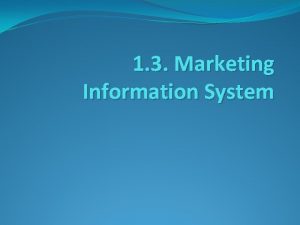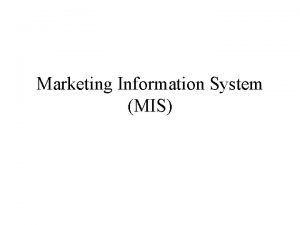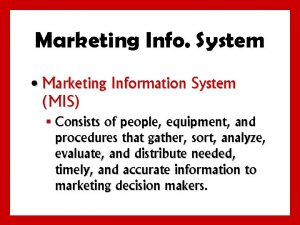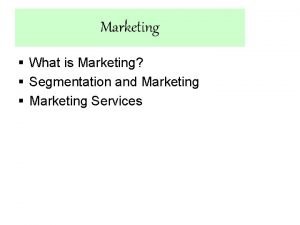MARKETING INFORMATION SYSTEM AND MARKETING RESEARCH Marketing and




































- Slides: 36

MARKETING INFORMATION SYSTEM AND MARKETING RESEARCH

Marketing and information § § Macroenvironment Customers Competition Strategic management MIS - mainly concerned with how to manage information: § Ongoing information eg sales record § Monitored information - about the economy § Requested information - Surveys

Marketing Information System § An MIS consists of people, equipment, and procedures to gather, sort, analyze, evaluate, and distribute needed, timely, and accurate information to marketing decision makers. § The MIS helps managers to: 1. Assess Information Needs 2. Develop Needed Information 3. Distribute Information FUNCTIONS OF MIS

1. Assessing Information Needs Conduct Interviews and Determine What Information is Desired, Needed, and Feasible to Obtain Monitors Environment for Information Managers Should Have Examine Cost/ Benefit of Desired Information

2. Developing Information Obtains Needed Information for Marketing Managers FROM: Internal Data Collection of Information from Data Sources Within the Company + Marketing Intelligence Collection and Analysis of Publicly Available Information about Competitors and the Marketing Environment + Marketing Research Design, Collection, Analysis, and Reporting of Data about a Situation

3. Distributing Information Right Information + Right Time + Right Managers Distributes Routine Information for Decision Making Distributes Nonroutine Information for Special Situations

The Marketing Information System

Marketing Research § Marketing research is the systematic and objective identification, collection, analysis, dissemination, and use of information for the purpose of assisting management in decision making related to the identification and solutions of problems and opportunities in marketing (Naresh Malhotra)

Purposes of Marketing Research § § § § Identify changes in the existing market Build up a knowledge bank Improve market awareness & opportunities Reduce risk and uncertainty Support marketing mix decisions Support marketing planning and controls Improve understanding of marketing Solve ad hoc problems

Marketing and Market Research § Marketing research - is the gathering of information on all activities of marketing § Market research - is the gathering of information on a particular market for a product or service § Marketing research has a wider scope than market research

Types of research information § Market research - information about the market for a given product/service - likely demand market characteristics & trends -market share § Promotion research -effects of advertising on sales -effectiveness of promotion methods/media; sales areas

Types of research information § Product research covers information about the proposed/improved product: -competing products -customer acceptance -test marketing of potential new users § Price research - customer perception of price/quality/value profit margin § Distribution research -location & design of distribution centre costs of transportation/storage - -

Why Research? § To Avoid. . . § To Reduce. . . § To Obtain . . . Focus § What do you want to know? § Why do you want to know it? § Specifically, how are you going to use the information obtained?

The Marketing Research Process Defining the Problem and the Research Objectives Developing the Research Plan Implementing the Research Plan Interpreting and Reporting the Findings

Defining the problem and objectives § Decision problem = „what needs to be done“? § Research problem = „what information should be provided to help to decide what needs to be done? “ + „how the information can be best secured? “ § DP: Should we invest into new service investment? § RP: Will the offer of the new service create such a surplus which would cover the investment and ensure the profit for the next 3 years? § RO: Do customers want such service? Whcih segment of customers? What are their characteristics? Will the service make better image? How many customers would use this service? . .

1. Defining the Problem & Objectives Exploratory Research Gathers preliminary information that will help define the problem and suggest hypotheses. Descriptive Research Describes „something“ (e. g. , market potential for a product, demographics or attitudes). Causal Research Tests hypotheses about cause-and-effect relationships.

Exploratory Research § Generally provides qualitative data § May take several forms – Consumer interviews – Focus groups – Case studies – Ethnography – Projective techniques

Descriptive Research § § § Utilizes a large sample of participants as base Generally provides quantitative data Designs – Cross-sectional design involves the systematic collection of quantitative information from one or more samples of respondents at one point in time – Longitudinal design tracks the responses of the sample of respondents over time

Causal Research § Attempts to understand cause-and-effect relationships § Factors that might cause a change are independent variables while the variables that are affected are dependent variables § Experimental design allows researchers to control possible explanations for the effect

2. Developing research plan § What, how, when, who, where? ? ? § Includes: – Determining the exact information needed – Developing a plan for gathering it efficiently – Deciding the form of the final results presentation § Outlines: – – – Sources of data and information Specific research approaches Contact methods Sampling plans Instruments for data collection

Types and surces of data and information

Using secondary data § As a backdrop to primary research eg when doing basis research in unfamiliar territory § As a substitute for research - information already available or in cases where it is not worth doing primary research § As a technique in itself - eg for collecting historic data on market trends

Comparison on Data Types Secondary · Dfn: data already exist · Exs: census, government, Dun&B CDRoms, corporate library, scanner data (Nielsen, ) · +’s: quick, cheap, easy, focuses research, can answer Q, benchmark · -’s: doesn’t fit problem, outdated Primary · Dfn: data you collect for purpose at hand · Exs: focus group, survey, interviews, telemarketing · +’s: tailored to needs, current · -’s: takes time to collect, expensive Strengths and weaknesses are complementary! So. . . any good research project should have both!

TYPES OF SECONDARY DATA

Primary Data § Research Approach: § Observation research using people or machines – Discovers behavior but not motivations § Survey research - who, what, when, why, where, how…. § Experimental research – investigates cause and effect relationships – What if…. The gathering of primary data by observing relevant people, actions, and situations. Ethnographic research: - Observation in “natural environment” Mechanical observation: - People meters - Checkout scanners

Qualitative V Quantitative Research § Qualitative research -seeks in-depth, openended and unquantifiable information describing opinions, values etc, rather than sizes and amounts in numerical form § Quantitative research -seeks structured responses that can be quantified in numerical form rather than general, open-ended information

Collection methods § Communication – Mail questionnaires – Telephone interviews – Face-to-face interviews – Online questionnaires SURVEY § Observation + recording – Personal – Mechanical …People Meters, Supermarket … Scanners, Galvanometer, Eye Cameras

Communication - inquiry FACE – to – FACE - Personal interview survey_ § § § In-home (door-to-door) interview Focus-group interview Telephone depth interview Shopping mall intercept interviews On-site computer interviews PROBLEMS? ? ? § What questions to ask § Form of each question – Closed-ended, Dichotomous, Open-ended, Multiple-Choice… § Wording § Ordering

Typical problems in wording questions

Choosing the Sample § Requires 3 Decisions: – Who is to be surveyed? § Sample – segment of the population selected to represent the population as a whole. § Sampling unit – How many people should be surveyed? § Sample size – How should the people in the sample be chosen? § Sampling procedure

– Sampling § Population—all the elements, units, or individuals of interest to researchers for specific study § Sample—a limited number of units chosen to represent the characteristics of a total population – Types of sampling – Probability—each element has an known chance for study – Random—each element has an equal chance for study – Stratified—study population divided into like groups – Nonprobability: element’s likelihood of study is unknown – Quota: population is grouped and elements are arbitrarily chosen

3. Implementing the research plan Collecting and analysing the data § Pilot research – to test the research approach, sample, objectives, quality of …. . § Collection § Coding § Tabulating § Calculating, summarizing, analysing § Interpretation

4. Interpreting and Reporting the Findings Prepare the Research Report § § § Executive summary A description of research methods Discussion of results Limitations of study Conclusions and recommendations

Key concept in assessing the quality of research. § Validity: refers to how well a research design(and the research method and the measures or questions used) measure what it claims to measure. § Reliability : refers to the consistency of research results. In other words, if we repeat the research, or if a different interviewer undertake the fieldwork, will we get the same result § Representativeness:

Basic information about survey Gf. K reserves copyright to all survey concepts, methodologies, and instruments including, but not limited to, graphic and tabular presentations. The Customer receives the survey reports for his own use exclusively. Unless agreed otherwise, their content may be published or passed on to third parties in part or in whole only upon written agreement by Gf. K. Nor may they be reproduced, printed or stored, processed or disseminated in information and documentation systems of any kind for this purpose. If the Customer wishes to quote parts or all of a survey report he must make it clear that it is a quote and name the Market research institute as the author of the report. This applies but is not limited to data quoted in advertising messages, public relations releases or broadcasted appearances and other publicly available company's materials. Type of research: Omnibus Research agency: Gf. K - Centre for Market Research topic: Structure of book buyers in Croatia Method: Face-to-face in-home interviews Sample size: 1. 000 respondents, aged 15+ years Sampling: two-stage stratification by region and size of residence; at each sampling point the addresses are drawn at random, and in each household respondents are randomly selected Duration of fieldwork: 10. - 24. March 2005. Output: Analysis of the results Tables by standard statistics Project manager: Senka Brajovic Tel. : +385 (0)1 4921 222 / ext. 111 GSM: +385 (0)91 4921 111 Fax: +385 (0) 1 4921 223 E-mail: senka. brajovic@gfk. hr

§ www. utdallas. edu/~axs 050300/Slides%20 Week%205%20 Wednesday. ppt § www. biz. colostate. edu/faculty/lonc/BK 320%20 PPTS/Street%20 Smart %20 Market%20 Research. PPT § www. ceebp. org/Report_CEEBP_III_wave. ppt § fpmdi. § cfans. umn. edu/mktg 6051/Lecture/Secondary. ppt § econ. ucsc. edu/faculty/flannery/marketing/Power. Points/kotler 04_media. ppt § mgtclass. mgt. unm. edu/MIDS/Shul/Power. Points%20 ch 04/armstrong 04 _media. ppt § acad. erskine. edu/facultyweb/santella/Marketing%20 Research/mrslides /ch 02 cb 6 e. ppt § home. olemiss. edu/~rcosenza/sol 4 ppts/solomon 04_basic. ppt § learning. north. londonmet. ac. uk/mt 102/researchmtlecture. ppt
 Marketing information system and marketing research
Marketing information system and marketing research Finer segmentation
Finer segmentation Marketing information systems and marketing research
Marketing information systems and marketing research Marketing information systems and marketing research
Marketing information systems and marketing research Marketing information system kotler
Marketing information system kotler Marketing information systems and marketing research
Marketing information systems and marketing research Current research information system
Current research information system Management problem vs research problem
Management problem vs research problem Tactical marketing information system
Tactical marketing information system Marketing information system kotler
Marketing information system kotler Capturing marketing insights
Capturing marketing insights Benefits of secondary research
Benefits of secondary research Recruise meaning
Recruise meaning Marketing information system mis
Marketing information system mis Marketing information system
Marketing information system Define marketing information management
Define marketing information management Market research demand forecasting
Market research demand forecasting Data analy
Data analy Global marketing information system
Global marketing information system Mis meaning
Mis meaning Marketing research system
Marketing research system Is earth a closed system or open system
Is earth a closed system or open system Respiratory system circulatory system digestive system
Respiratory system circulatory system digestive system Knesset research and information center
Knesset research and information center Missouri economic research and information center
Missouri economic research and information center Research scope definition
Research scope definition Contrast applied research and basic research
Contrast applied research and basic research Operational thought
Operational thought Applied vs fundamental research
Applied vs fundamental research Conclusive research design meaning
Conclusive research design meaning Practical research 2 nature of inquiry and research
Practical research 2 nature of inquiry and research Research problem and research objectives
Research problem and research objectives Imperfect vs incomplete information
Imperfect vs incomplete information Information overload research group
Information overload research group Research report vs research proposal
Research report vs research proposal Methods versus methodology
Methods versus methodology Sample of appendices in research paper
Sample of appendices in research paper


